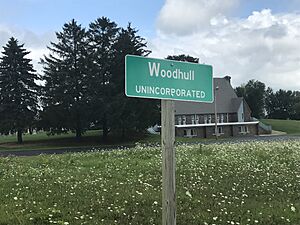Administrative divisions of Wisconsin facts for kids
The administrative divisions of Wisconsin are the different ways the state of Wisconsin is organized into smaller areas for local government. These include counties, cities, villages, and towns. All of these are types of local governments that serve the people living there. There are also special districts, like school districts, which handle specific needs for a region.
Whether a community is called a city, village, or town doesn't just depend on how many people live there or how big it is. It depends on the type of government the residents choose and the Wisconsin State Legislature approves. Some cities and villages can even be in more than one county. For example, the city of Whitewater is in both Walworth and Jefferson counties.
Contents
Counties: Wisconsin's Main Divisions
Counties are the main political divisions in Wisconsin. Each county has a special place called a county seat. This is usually a large or central city or village where the county government offices are located. Inside each county, you'll find cities, villages, and towns. As of 2016, Wisconsin had 72 counties.
How Counties are Governed
A group called the Board of Supervisors leads the county government. These supervisors are chosen in elections where they don't run as part of a political party. They serve for two years. However, in Milwaukee County, supervisors used to serve four years. This changed to two years in 2013.
Counties also have a top leader, but the title can be different. Some counties have a County Executive, who is elected for four years. Other counties have a County Administrator or Administrative Coordinator, who is appointed. Other important officials include sheriffs, district attorneys, and treasurers. These officials are elected for four-year terms.
What Counties Do
Counties are in charge of many important services. They help with social services like child welfare and care for older adults. They also manage public lands, such as parks. Law enforcement and road maintenance are also handled by the county, often working with local cities and villages.
Cities and villages have special powers from the state constitution. Counties and towns, however, get their powers from the state legislature. This means the state can change what counties and towns are allowed to do. Cities and villages have more freedom to make their own rules.
As of 2022, most of Wisconsin's 72 counties also collect their own sales tax. This is a small extra tax on things you buy. It helps pay for local needs, like fixing county roads. This local sales tax is usually a small percentage, added to the state's 5% sales tax.
Cities: Urban Centers of Wisconsin

In Wisconsin, a city is an independent area within one or more counties. Cities offer almost all services to their residents. They have the most freedom to make their own rules and collect taxes compared to other local governments. Cities are usually more developed and have more people than towns. As of 2015, Wisconsin had 190 cities.
City Powers and Leadership
Cities have something called "home rule" authority. This means they can make many of their own decisions about how they are run and what public policies they have. These decisions must still follow state laws.
Cities can choose to have an elected mayor or hire a city administrator or manager. If they have a city administrator, the head of the city council might still be called a mayor. Cities are governed by Common or City Councils. These councils include the mayor or city manager and elected aldermen or council members. Other city officials include a treasurer, clerk, and health officials. Cities can also choose to have an engineer, comptroller, or other specialized roles.
City Classes and Growth
Cities in Wisconsin are grouped into four classes based on their population:
- First class: Cities with 150,000 or more people.
- Second class: Cities with 39,000 to 149,999 people.
- Third class: Cities with 10,000 to 38,999 people.
- Fourth class: Cities with 9,999 or fewer people.
Sometimes, a city might have enough people to be in a higher class but stays in its current class. This happens because a city needs to make certain government changes and the mayor must make an official announcement to move up a class. For example, Madison has over 150,000 people but is still a second-class city.
To become a city, a community needs at least 1,000 people in a rural area or 5,000 in an urban area. Cities can grow by adding land from nearby towns. This often happens when landowners want city services.
Villages: Smaller Incorporated Areas

In Wisconsin, a village is an independent area located within one or more counties. Villages provide various services to their residents. They also have some "home rule" power and can collect taxes. As of 2015, Wisconsin had 407 villages.
Becoming and Governing a Village
To become a village, a community needs at least 150 people in a rural area. In an urban area, it needs at least 2,500 people. Like cities, villages have "home rule" authority. This means they can make many of their own decisions about how they are run, as long as they follow state law.
Villages are led by a Village President and a Board of Trustees. Other village officials include a clerk, treasurer, and assessor. Some villages choose to hire a village manager to handle daily tasks instead of having an elected president. As of 2015, nine villages had a manager. Another 77 villages had a village administrator.
Towns: Unincorporated Areas with Limited Services
In Wisconsin, a town is an area within a county that is not officially incorporated as a city or village. If you live in Wisconsin and not in a city or village, you live in a town. Towns offer fewer services to their residents compared to cities or villages. The U.S. Census Bureau calls Wisconsin towns "minor civil divisions." As of 2015, Wisconsin had 1,255 towns.
Town Names and Authority
Towns often have the same names as nearby cities or villages. For example, the Town of Cedarburg is next to the city of Cedarburg. Also, the Town of New Glarus completely surrounds the village of New Glarus. Sometimes, there can even be towns with the same name in different counties. For instance, there are towns named Albion in Dane County, Jackson County, and Trempealeau County.

Towns have less power than villages and cities. They do not have "home rule." Instead, they only have the specific powers given to them by state law. At a minimum, towns are responsible for maintaining their roads. They may also have volunteer or municipal fire departments. Towns can choose to offer more services, like zoning, which can overlap with county services. Because towns usually provide fewer services, residents often pay lower taxes than those in cities or villages. Some towns have been given special "village powers," which increases their authority.
Town Government and Meetings
Towns are governed by Town Boards, led by a board chairperson. These boards usually have three supervisors. However, towns with "village powers" or more than 2,500 people can have up to five supervisors. Town supervisors are elected every two years. Towns also have clerks, treasurers, and assessors, who can be either elected or appointed.
Every town must hold an annual town meeting in early April. At this meeting, the voters can approve actions for the town board. They can also change the number of supervisors or their wages.
Town Size and Evolution
Cities and villages often take over parts or all of nearby towns. For example, in 1964, the entire Town of Preble became part of the city of Green Bay. This ended its status as a town. Sometimes, towns become very small due to these annexations. The Town of Germantown is only about 1.7 square miles (4.4 km2), and the Town of Brookfield is about 5.5 square miles (14.2 km2). In contrast, the Town of Winter covers about 279.5 square miles (723.9 km2). Most towns are about the size of a survey township, which is 36 square miles (93 km2). The Town of Menominee is special because it covers the same area as Menominee County, about 365 square miles (945 km2). This is because of its history and connection to the Menominee Indian Reservation.
In southern Wisconsin, towns often match the boundaries of "survey townships." These were created to map land and are not political areas. These survey townships were part of the Public Land Survey System. They are divided into 36 sections, each one square mile. In Wisconsin, this grid system started from a specific point near Hazel Green, Wisconsin in 1831. You can still see this grid today in how major streets are laid out, especially in cities like Milwaukee.
Towns are the only type of government where residents can directly vote on decisions at local meetings. Towns usually have fewer people living in them. The town with the most people in Wisconsin is Grand Chute. It has services, taxes, and a city-like feel. When towns grow very large, their simple government style can become difficult to manage. They often decide to become a village or city. For example, the village of Fox Crossing incorporated in 2016, and the village of Kronenwetter did so in 2002–2003.
- See also urban town, a proposal for semi-incorporation of more urbanized towns.
Unincorporated Communities: Named Places Without Government

Across Wisconsin, there are many unincorporated communities. These are places that have a name but don't have their own local government. Instead, they are managed by the town or municipality they are located within. These named places are useful for finding specific locations and are sometimes listed in official records.
Many of these places are small, with just a few houses, a church, or a local business like a store. Even though they don't have their own government, most are well-known. They are often marked with green highway signs that show the place name with the word 'Unincorporated' underneath. Many of these names are also on official Wisconsin state highway maps. Examples include Frog Station, Poland, and North Leeds.
See Also
- urban town


